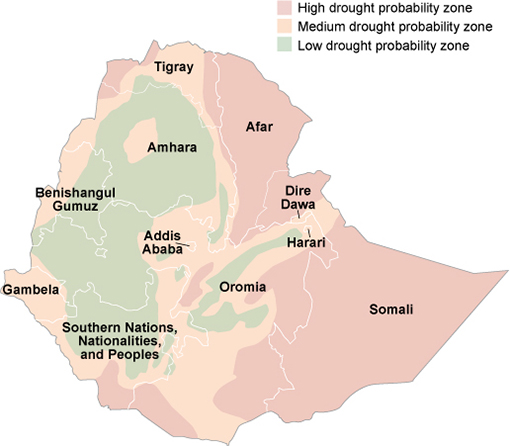10.3.1 How many Ethiopians are affected by drought?
More than 57 million people across Ethiopia have been affected by droughts since 1980 (MoWR/NMA, 2007). Table 10.2 shows the frequency and impacts of droughts between 1964 and 2003.
| Years | Regions affected | Impacts on human life and property |
| 1964–66 | Tigray and Wollo | About 1.5 million people affected |
| 1973–74 | Tigray and Wollo | About 200,000 people and 30% of livestock dead |
| 1978–79 | Southern Ethiopia | 1.4 million people affected |
| 1982 | Northern Ethiopia | 2 million people affected |
| 1983–84 | Ethiopia | 8 million affected, one million dead and many livestock lost |
| 1987–88 | Ethiopia | 7 million people affected |
| 1990–92 | Northern, eastern, south-eastern Ethiopia | 0.5 million people affected |
| 1993–94 | Tigray and Wollo | 7.6 million people affected |
| 2000 | Ethiopia | 10.5 million people affected |
| 2002–03 | Ethiopia | About 13 million people needed food assistance. |
Look at Table 10.2. What trend over time do you notice in the impacts of drought and famine in the period shown?
The number of people affected by drought and famine has increased during this period, from 1.5 million in 1964–66 to more than 13 million in 2002–03.
Even though the population of Ethiopia has increased over the period from 1964 to 2003 (which could partly explain the increase in numbers affected), the later droughts covered larger areas of the country and were more severe. Currently more than 10 million people live in the drought-prone areas of Ethiopia shown in Figure 10.6.

Based on Figure 10.6, which parts of Ethiopia are most vulnerable to drought?
The most drought-vulnerable areas in Ethiopia include Somali, Afar, parts of Tigray, eastern and southern Oromia, and southern SNNPR.
10.3 Drought
